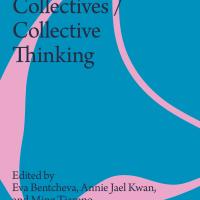Book Section
Eva Bentcheva
Artist-Curator Collectives in Southeast Asia
Eva Bentcheva analyses artist-curator collectives in Southeast Asia that reject colonial art systems by redefining collaboration through community, responsibility, and presence. Drawing on the case studies of The Artists Village in Singapore, the Chiang Mai Social Installation in Thailand, and Green Papaya in the Philippines, she shows how collectivity is harnessed to produce localized publics and pedagogies, as well as self-organized spaces that reimagine art as social infrastructure.
Keywords: Southeast Asia; modern and contemporary art; artist-curators; The Artists Village; Chiang Mai Social Installation; Green Papaya; collectivity
| Title |
Artist-Curator Collectives in Southeast Asia
|
| Author(s) |
Eva Bentcheva
|
| Identifier | |
| Description |
Eva Bentcheva analyses artist-curator collectives in Southeast Asia that reject colonial art systems by redefining collaboration through community, responsibility, and presence. Drawing on the case studies of The Artists Village in Singapore, the Chiang Mai Social Installation in Thailand, and Green Papaya in the Philippines, she shows how collectivity is harnessed to produce localized publics and pedagogies, as well as self-organized spaces that reimagine art as social infrastructure.
|
| Is Part Of | |
| Place |
Berlin
|
| Publisher |
ICI Berlin Press
|
| Date |
28 October 2025
|
| Subject |
Southeast Asia
modern and contemporary art
artist-curators
The Artists Village
Chiang Mai Social Installation
Green Papaya
collectivity
|
| Rights |
© by the author(s)
Except for images or otherwise noted, this publication is licensed under a Creative Commons Attribution-ShareAlike 4.0 International License.
|
| Language |
en-GB
|
| page start |
77
|
| page end |
88
|
| Source |
Thinking Collectives / Collective Thinking, ed. by Eva Bentcheva, Annie Jael Kwan, and Ming Tiampo, Worlding Public Cultures (Berlin: ICI Berlin Press, 2025), pp. 77–88
|
References
- Documenta. Politik und Kunst (2021–22) at the Deutsches Historisches Museum in Berlin
- Bentcheva, Eva, ‘ Three Kings and Sound Bags: Revisiting Three Kings and Sound Bags (1979) as Philippine “Experimental Art” of the 1970s’, Southeast of Now, 6.2 (2022), pp. 187–94 <https://doi.org/10.56159/sen.2022.a871499>
- Bentcheva, Eva, ‘From Ephemeral Experiences to Lasting Legacies: Discourses on Experimental Art in the Philippines during the 1960s and 1970s’, Tate Papers, 32 (Autumn 2019) <https://www.tate.org.uk/research/tate-papers/32/discourses-experimental-art-philippines-1960s-1970s> [accessed 17 March 2023]
- Butt, Zoe, ‘Spirit of Friendship: Artist Groups in Vietnam since 1975’, Southeast of Now: Directions in Contemporary and Modern Art in Asia, 2.2 (2018), pp. 145–79 <https://doi.org/10.1353/sen.2018.0005>
- Cristóbal, Geronimo, ‘Pushing Against the Roof of the World: ruangrupa’s Prospects for documenta fifteen’, Third Text (26 October 2020) <http://www.thirdtext.org/cristobal-ruangrupa> [accessed 10 August 2024]
- Flores, Patrick, Past Peripheral: Curation in Southeast Asia (NUS Press, 2008)
- Green Papaya Art Projects, in Roundtable on Collective Work, pp. 275–78
- Juliastuti, Nuraini, ‘Ruangrupa: A Conversation on Horizontal Organisation’, Afterall (2012) <https://www.afterall.org/articles/ruangrupa-a-conversation-on-horizontal-organisation/> [accessed 20 August 2024]
- Juliastuti, Nuraini, Commons Museums: Pedagogies for Taking Ownership of What is Lost (ICI Berlin Press, 2024) <https://doi.org/10.37050/wpc-ca-04>
- König, Claudia, ‘documenta fifteen: Awaiting ruangrupa. A Performative Walk through Kassel, September 2021’, Southeast of Now: Directions in Contemporary and Modern Art in Asia, 6.1 (2022), pp. 211–20 <https://doi.org/10.1353/sen.2022.0012>
- Quijon, Carlos, Jr., in Roundtable on Collective Work, special issue of Southeast of Now: Directions in Contemporary and Modern Art in Asia, 5.1 and 2 (October 2021), pp. 259–60 <https://doi.org/10.1353/sen.2021.0009>
- Rath, Amanda Katherine, and Wulan Dirgantoro, ‘Editorial Introduction in the Making: Experiment and Experimentation in Southeast Asian Art’, special issue of Southeast of Now: Directions in Contemporary and Modern Art in Asia, ed. by Amanda Katherine Rath and Wulan Dirgantoro, 6.2 (October 2022), pp. 2–9 <https://doi.org/10.56159/sen.2022.a871489>
- Santos, Boaventura de Sousa, ‘Public Sphere and Epistemologies of the South’, Africa Development, 37.1 (2012), pp. 43–67 <https://www.ajol.info/index.php/ad/article/view/87540> [accessed 20 August 2024]
- Sternfeld, Nora, ‘Para-Museum of 100 Days: documenta between Event and Institution’, in Documenta: Curating History of the Present, ed. by Nanne Buurman and Dorothee Richter, special issue of OnCurating, 33 (2017), pp. 165–70 <https://www.on-curating.org/issue-33-reader/para-museum-of-100-days-documenta-between-event-and-institution.html> [accessed 13 March 2023]
- Stimson, Blake, and Gregory Sholette, eds, Collectivism after Modernism: The Art of Social Imagination after 1945, NED-New edition (University of Minnesota Press, 2007)
- Teh, David, ‘ Baramee. Thai Relational Art and the Politics of Withdrawal’, Thai Art: Currencies of the Contemporary (MIT Press, 2017), pp. 109–44
- Zarobell, John, ‘Global Art Collectives and Exhibition Making’, Arts, 11.2 (2022), 38 <https://doi.org/10.3390/arts11020038>
Cite as:
Eva Bentcheva, ‘Artist-Curator Collectives in Southeast Asia’, in Thinking Collectives / Collective Thinking, ed. by Eva Bentcheva, Annie Jael Kwan, and Ming Tiampo, Worlding Public Cultures (Berlin: ICI Berlin Press, 2025), pp. 77-88 <https://doi.org/10.37050/wpc-co-01_06>

